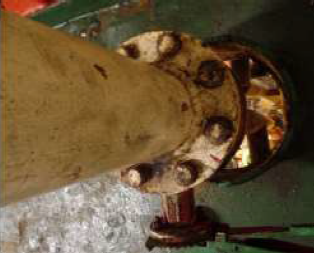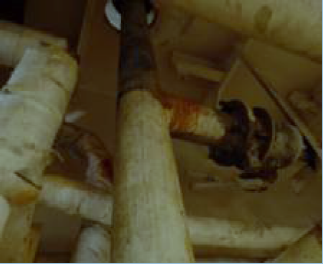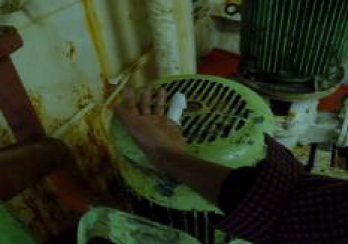Lost time injury (LTI): Finger injury whilst working in engine room
A member has reported an incident in which a fitter was injured in the engine room while removing a leaking pipe for repairs. The incident occurred when a minor leak was found at the T-junction of the sea water inlet to the fresh water generator. The location of the leak was close to the bulkhead, where welding repair could not be done, hence the pipe had to be removed for permanent repairs.
A toolbox talk was conducted before starting the job by the second engineer and crew, who were using appropriate personal protective equipment (PPE) for the task. As per the plan, the trainee wiper was to hold the safety rope and lower the pipe as instructed and the 4th engineer would align the pipe to pass through the opening. A fitter was stationed at the lower end on the deck below. After the flanges were disconnected and while lowering the pipe, the trainee wiper’s hand slipped from the rope causing sudden drop of the pipe, jamming the fitter’s left hand little finger between the motor and the lower flange of the pipe. This caused a severe crush injury with a deep laceration. The fitter was declared unfit for duty and was signed off.




Our member’s investigation revealed the following:
- Immediate cause:
- improper use of equipment – safety rope not suitable for the purpose;
- Causal factor (management, competence or individual factor):
- inadequate resources – additional resources not stationed in place
- inadequate tools/equipment
- ineffective toolbox meeting
- inadequate supervision
- Root cause (inadequate system, standard or compliance):
- Risk was considered to be tolerable – the work party considered the work to be safe. There was inadequate understanding of the risks involved.
The following preventative actions were taken:
- Ensure more effective toolbox meetings and proper understanding of risks and take actions to prevent injuries/incidents; . A more thorough risk assessment is required for such tasks; . Improve existing work methods – increase awareness of the problems that can occur when working in close proximity of parts being lifted or moved; . Supervisory personnel should take extra precautions and ensure they supervise the area and job well to include everything that can possibly go wrong;
- Ensure good communication such as use of ultra-high frequency (UHF) radio, particularly when inter-dependent teams are working in different locations and are not visible to one another or cannot hear each other properly due to background noise;
- Use of correct tools/equipment for the job;
- Ensure adequate resources stationed where required.
Crushed fingers are a depressingly common occurrence even today in IMCA member operations. Any number of them can be found amongst the safety flashes of the last 10 years. members may wish to refer to the following incident (search word: crush):
Members should also be aware that IMCA has a pocket safety card on this topic:
Safety Event
Published: 13 April 2016
Download: IMCA SF 08/16
IMCA Safety Flashes
Submit a Report
IMCA Safety Flashes summarise key safety matters and incidents, allowing lessons to be more easily learnt for the benefit of all. The effectiveness of the IMCA Safety Flash system depends on Members sharing information and so avoiding repeat incidents. Please consider adding safetyreports@imca-int.com to your internal distribution list for safety alerts or manually submitting information on incidents you consider may be relevant. All information is anonymised or sanitised, as appropriate.
IMCA’s store terms and conditions (https://www.imca-int.com/legal-notices/terms/) apply to all downloads from IMCA’s website, including this document.
IMCA makes every effort to ensure the accuracy and reliability of the data contained in the documents it publishes, but IMCA shall not be liable for any guidance and/or recommendation and/or statement herein contained. The information contained in this document does not fulfil or replace any individual’s or Member's legal, regulatory or other duties or obligations in respect of their operations. Individuals and Members remain solely responsible for the safe, lawful and proper conduct of their operations.
